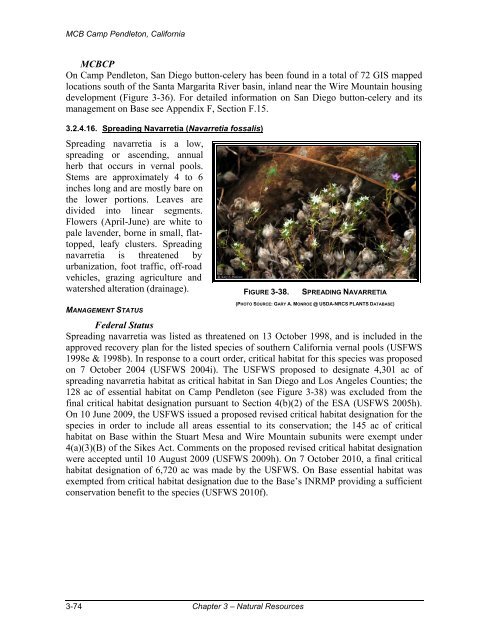Chapter 3 - Natural Resources - Marine Corps Base Camp Pendleton
Chapter 3 - Natural Resources - Marine Corps Base Camp Pendleton
Chapter 3 - Natural Resources - Marine Corps Base Camp Pendleton
You also want an ePaper? Increase the reach of your titles
YUMPU automatically turns print PDFs into web optimized ePapers that Google loves.
MCB <strong>Camp</strong> <strong>Pendleton</strong>, California<br />
MCBCP<br />
On <strong>Camp</strong> <strong>Pendleton</strong>, San Diego button-celery has been found in a total of 72 GIS mapped<br />
locations south of the Santa Margarita River basin, inland near the Wire Mountain housing<br />
development (Figure 3-36). For detailed information on San Diego button-celery and its<br />
management on <strong>Base</strong> see Appendix F, Section F.15.<br />
3.2.4.16. Spreading Navarretia (Navarretia fossalis)<br />
Spreading navarretia is a low,<br />
spreading or ascending, annual<br />
herb that occurs in vernal pools.<br />
Stems are approximately 4 to 6<br />
inches long and are mostly bare on<br />
the lower portions. Leaves are<br />
divided into linear segments.<br />
Flowers (April-June) are white to<br />
pale lavender, borne in small, flattopped,<br />
leafy clusters. Spreading<br />
navarretia is threatened by<br />
urbanization, foot traffic, off-road<br />
vehicles, grazing agriculture and<br />
watershed alteration (drainage).<br />
FIGURE 3-38.<br />
SPREADING NAVARRETIA<br />
MANAGEMENT STATUS<br />
(PHOTO SOURCE: GARY A. MONROE @ USDA-NRCS PLANTS DATABASE)<br />
Federal Status<br />
Spreading navarretia was listed as threatened on 13 October 1998, and is included in the<br />
approved recovery plan for the listed species of southern California vernal pools (USFWS<br />
1998e & 1998b). In response to a court order, critical habitat for this species was proposed<br />
on 7 October 2004 (USFWS 2004i). The USFWS proposed to designate 4,301 ac of<br />
spreading navarretia habitat as critical habitat in San Diego and Los Angeles Counties; the<br />
128 ac of essential habitat on <strong>Camp</strong> <strong>Pendleton</strong> (see Figure 3-38) was excluded from the<br />
final critical habitat designation pursuant to Section 4(b)(2) of the ESA (USFWS 2005h).<br />
On 10 June 2009, the USFWS issued a proposed revised critical habitat designation for the<br />
species in order to include all areas essential to its conservation; the 145 ac of critical<br />
habitat on <strong>Base</strong> within the Stuart Mesa and Wire Mountain subunits were exempt under<br />
4(a)(3)(B) of the Sikes Act. Comments on the proposed revised critical habitat designation<br />
were accepted until 10 August 2009 (USFWS 2009h). On 7 October 2010, a final critical<br />
habitat designation of 6,720 ac was made by the USFWS. On <strong>Base</strong> essential habitat was<br />
exempted from critical habitat designation due to the <strong>Base</strong>’s INRMP providing a sufficient<br />
conservation benefit to the species (USFWS 2010f).<br />
3-74 <strong>Chapter</strong> 3 – <strong>Natural</strong> <strong>Resources</strong>

















